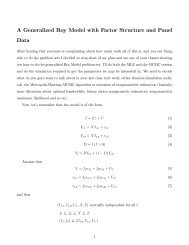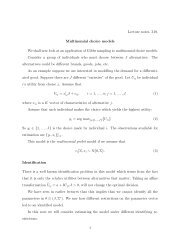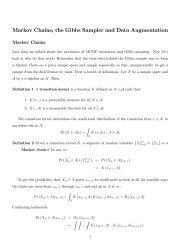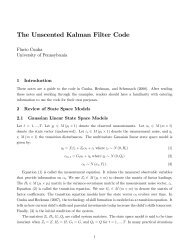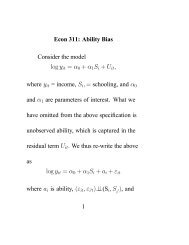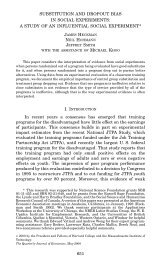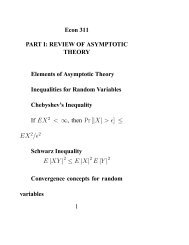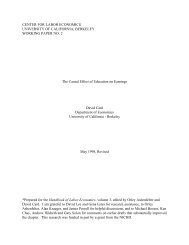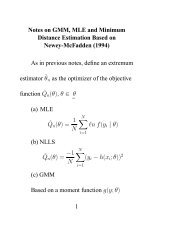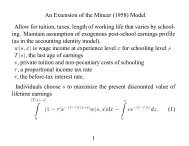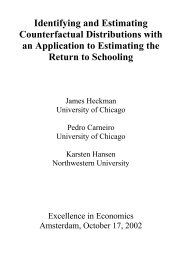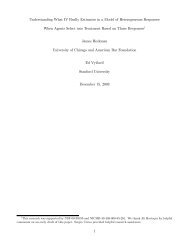OECD (2000)
OECD (2000)
OECD (2000)
Create successful ePaper yourself
Turn your PDF publications into a flip-book with our unique Google optimized e-Paper software.
D1<br />
Statutory Salaries of Teachers in Public Primary and Secondary Schools<br />
This indicator shows the<br />
starting, mid-career<br />
and maximum statutory<br />
salaries of teachers in<br />
public primary and<br />
secondary education.<br />
Statutory salaries of<br />
teachers are compared<br />
in absolute terms<br />
with GDP per capita<br />
and with salaries<br />
of other workers.<br />
POLICY CONTEXT<br />
Teachers’ salary levels can affect both the desirability of entering the teaching<br />
profession and the ability of schools to retain the most skilled teachers.<br />
Ensuring that there will be enough skilled teachers to educate all children is an<br />
important policy concern in all <strong>OECD</strong> countries. Teachers’ salaries are also the<br />
single largest factor in the cost of providing education. The size of education<br />
budgets reflects either an explicit or implicit trade-off between a number of<br />
interrelated factors, including statutory teachers’ salaries, student/teaching staff<br />
ratios (Indicator B7), the quantity of instructional time planned for students<br />
(Indicator D4), and the designated number of teaching hours (Indicator D3).<br />
This indicator examines the starting, mid-career and maximum statutory salaries<br />
of teachers with the minimum level of qualifications required to be certified as<br />
a teacher of public primary and secondary education. First, statutory salaries are<br />
examined in relation to GDP per capita. This is a rough measure of investment in<br />
teachers relative to a country’s ability to finance educational expenditure. Second,<br />
statutory salaries are examined in comparable US dollars (adjusted for relative<br />
purchasing power) in order to determine the absolute volume of resources<br />
invested in each teacher. The salaries of teachers are then compared with the<br />
salaries of other workers, particularly those holding an ISCED 5A qualification, in<br />
order to examine the competitiveness of teaching relative to other occupations.<br />
Statutory salaries of teachers relative to GDP per capita<br />
Statutory salaries for teachers relative to GDP per capita are an indication of<br />
the extent to which a country invests in teaching resources, relative to the financial<br />
ability to fund educational expenditure. High salaries relative to GDP per capita<br />
suggests that a country is making more of an effort to invest its financial resources<br />
in teachers.<br />
Statutory salaries for<br />
teachers are relatively<br />
low in the Czech<br />
Republic, Hungary and<br />
Norway and relatively<br />
high in Korea, Spain<br />
and Switzerland.<br />
The relationship<br />
between teachers’<br />
salaries and per capita<br />
wealth is not<br />
straightforward.<br />
Statutory salaries for<br />
teachers with 15 years’<br />
experience in Korea and<br />
Switzerland are more<br />
than five times those<br />
in the Czech Republic<br />
and Hungary.<br />
Starting salaries and mid-career salaries are lowest relative to GDP per capita<br />
in the Czech Republic, Hungary and Norway for both primary and secondary<br />
teachers (Chart D1.1). Starting and mid-career salaries relative to GDP per capita<br />
are highest for public primary and secondary teachers in Korea and Spain, as well<br />
as in Switzerland for public lower and general upper secondary teachers. In Korea,<br />
the teachers’ salaries are approximately 1.7 times GDP per capita at the beginning<br />
of their careers and 2.7 times GDP per capita after 15 years’ experience.<br />
Although the Czech Republic and Hungary have both relatively low GDP per<br />
capita and low teachers’ salaries, other countries with GDP per capita below the<br />
<strong>OECD</strong> average, including Korea and Spain, have comparatively high teachers’ salaries.<br />
Norway and the United States, two countries with relatively high GDP per<br />
capita, spend a below-average proportion of their wealth on teachers’ salaries, and<br />
Switzerland spends an above-average proportion of its relatively high GDP per<br />
capita on teachers’ salaries.<br />
In the <strong>OECD</strong>, annual statutory salaries of public primary-school teachers with<br />
15 years’ experience range from below US$10 000 in the Czech Republic and<br />
Hungary to over US$40 000 in Japan and Switzerland. A primary teacher in<br />
Switzerland, the country with the highest statutory salary with 15 years’ experience,<br />
is paid almost five times as much as a primary teacher in Hungary, where the statutory<br />
starting salary is lowest, even after an adjustment for purchasing power parities.<br />
This difference has a large impact on the variation in education costs per<br />
student (Indicator B4).<br />
© <strong>OECD</strong> <strong>2000</strong><br />
208



